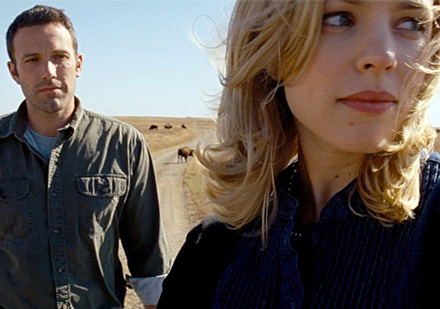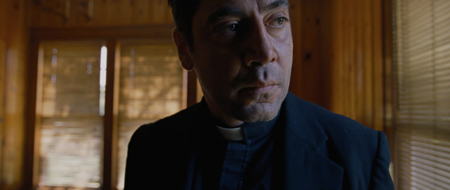|
|
Reviewed by Glenn Erickson
The movie business still holds some surprises: with at least half the output of the Hollywood establishment devoted to animated cartoons, safe sequels, comic book franchises and witless comedies, there still remains room for the occasional bona fide cinema artist. We once used to celebrate directors that followed their own muse, and Terrence Malick is on his own personal cinematic mission. As is his custom, the movie's images are intensely beautiful; just by looking at them lifts one's spirits.
With To the Wonder Malick steers deeper into impressionistic filmmaking than he did in The Tree of Life just a year before. We're told that, as with Tree of Life, this new movie is loosely adapted from Malick's own experiences. He doesn't assemble a dramatic narrative, but instead presents a forever drifting and changing "life flow" of a movie. His style is still experimental: we have lyrical images of great visual beauty, pieces of dialogue that function like fragments of memories, and hushed, semi-abstract voiceovers that function as spiritual meditations.

There is a story, even if we must infer its contours. Neil (Ben Affleck) passes blissful times with French-Russian beauty Marina (Olga Kurylenko) and her young daughter Tatiana (Tatiana Chiline) in Paris. Because of complications (?) in the breakup with Tatiana's father, Marina will have difficulties being re-married in a church. Neil brings the two back to his new home in Oklahoma, where he works measuring the effects of industrial pollution. At first things are ideal but then the relationship goes sour. Tatiana finds no friends in school and the adults begin to argue. Their local priest is Father Quintana (Javier Bardem). He advises Marina and is also shown making his rounds in the poorer sections of town. Quintana follows his calling to the best of his ability. Yet he is pained by the realization that his own faith is in doubt.
We don't know why, but Neil and Marina both become moody and resentful. Emotionally unstable, Marina does something rash and destructive. When she tells Neil, he can barely contain his rage. Marina returns to France, and Tatiana leaves to join her father in the Canary Islands. Now alone, Neil takes up with Jane (Rachel McAdams), a woman he knew back in school. Jane is losing her ranch, but they spend time there together. Jane is still traumatized by the loss of a child. She says that she can't afford to make another mistake with a man, and that she trusts Neil and loves him. We don't hear how Neil feels. And then we find out that Marina has changed her mind, and is coming back to be with Neil once more.
I'm surprised by how much 'story' is actually in To the Wonder, for it is less a series of events than an impressionistic flow of sensations and emotions. General audiences were underwhelmed, and festival audiences that marveled at Tree of Life were sharply divided in their reaction. To the Wonder may frustrate viewers expecting a conventional romantic drama, and most reviews see it as a disappointment after The Tree of Life, where we cared intensely about the husband and wife played by Jessica Chastain and Brad Pitt. The main problem is that Malick's characters are not satisfying. They remain strangers -- we don't even know if they are likeable people. Some Malick devotees may feel that the movie seems a bit repetitive and distant. Wonder also lacks the mysterious, fantastic imagery that made Tree of Life such a must-see event: no dinosaurs with a holy conscience, and no cutaways to a mystical light at the end of time.
In To the Wonder Terrence Malick stays comfortably inside his already established style. The pattern consists of a visual stream and a separate, parallel voiceover stream. Neither takes on a conventional storytelling task. As reported by the film editors interviewed for Criterion editions of Badlands and The Thin Red Line, Malick makes movies like a sculptor carves stone. He may have filmed every facet of the drama including involved dialogue scenes, and then pared the narrative linkage down to a minimum. Using the same sweeping visuals and dis-continuity between shots, Malick and his cinematographer Emmanuel Lubezki skate through the highs and lows of the characters' emotional lives. We sense changes in the relationships but most of the particulars are missing. We see the lovers' happiness fade, but we don't know why they can't sustain their joy.
I suppose a case can be made for this in real life: Malick says that feelings are the real proof of life and love and transcendence. I'm afraid I mostly see people hurting each other.

Malick's heavy stylization is now impossible to ignore. To some degree the character relationships are reduced to visual choreography. To the Wonder communicates as does a silent movie. Neil moves slowly. His most human moments come when he shares his knowledge with Marina, explaining how one can see the shadow of the earth in the sky at sunset (a visual beautifully captured by cameraman Lubezki). But Marina is always prancing, dancing and twirling like a ballerina. She never says, "I'm happy" but shows us through her movements. This silent movie approach becomes even more apparent in the scenes with Neil and Jane, that are not at all realistic. They take long walks around her ranch, but many shots capture them in poses that express their tentative relationship. If these compositional effects were less fluid we might reject them as too abstract or formal -- i.e., fake. Malick offsets this through his enforcement of mood and tone. The connection between these lovers always seems tentative. Jane has only to mention her fears about "trust" and "commitment" and we know the rest.
Malick uses textures as well. At one point Marina lays down on a porch covered with dry leaves. The leaves are like ashes, so their "deadness" can be interpreted as a symbol for the fading of Marina's love. We're well aware of the enthusiastic nature symbolism in all of Malick's movies, even the blunt-force symbolism of the final "bridge over troubled water" image in The Tree of Life. When Malik's camera tilts up toward the sky, it's perfectly clear that Malick wishes to express someone's yearning for heavenly guidance or approval -- his lovers, Father Quintana, or Malick himself. The best Malick films don't play the Obfuscation Game -- his lines of visual communication are in clear contact at all times.
Filmgoers are always looking for a story, when Malick wants them to look beyond. Just the same, we're likely to get bogged down in the very specifics that To the Wonder omits -- who left who, exactly? Why do they come back together? Was Neil fair to Jane? How was the barrier to Marina's second Catholic wedding removed? Malick wants instead to communicate ideas about Love without being bogged down by specifics. Although Wonder does not appear to jump back and forth in time, as did Tree of Life, it still seems to function as a very odd memory-picture. For Malick the memories that stick are from moments of pure emotion and rapture, that Father Quintana seems unable to find. One would think that Neil would remember intense moments of argument, and the hard decision process too. To the Wonder is in search of some Spirit of Love, and is not concerned with the details.
To the Wonder didn't strike me as deeply as some of Malick's other films for two reasons. I wasn't moved by the characters. Despite witnessing their travails I felt locked out of their problems. And I don't think Malick made connected the dots of his thesis, that the only reality is the Spiritual reality. In The Tree of Life I though that Malick was revisiting a motif from Intolerance, where D. W. Griffith reminds us repeatedly that Christianity is the cure for human evil: "The cradle, endlessly rocking." When Malick's Tree retraces the path of evolution and then kept returning to the cosmic view of an exploding cloud of interstellar gas, I take it as a reminder that there is order in the universe, and that the fragile humans in the story need to reach beyond their personal pain and struggle, and embrace the infinite. Malick expresses his entire religious world-view, when his characters meet in the beyond on a vast beach, their mortal fears now forgotten.
In To the Wonder Malick gives us a similar beach, which separates us from a glorious palace beyond the sea, with an elevated garden that might be the first steppingstone upward, 'to the wonder'. Malick ends on a view that integrates the beach with the island palace. My (conventional) mind interprets the image as saying that the goal of all of us imperfect lovers is to embrace the spiritual and seek the unattainable. That's pretty much what Malick was telling us the last time, and I'm not convinced that the new film presents as compelling a case.

Magnolia Home Entertainment's Blu-ray of To the Wonder is an audio-visual knockout. The phenomenally good camerawork -- unusual light conditions, heightened depth of field, delicate detail -- is flawlessly represented in the widescreen format. There are even several shots that reveal the moon hanging low in the sky. Cinematographer Lubezki captures a magical variety of natural lighting conditions, where the sky seems to cooperate with the emotions of the characters. Anybody can make Paris attractive, but this vision of Oklahoma is a revelation. I was in Kansas all of two days in 2010 - is the sky there normally this inspiring?
The soundtrack is Malick's typical blending of unusual classical cues, snatches of source music and always those haunting interior voices. The advice to play the soundtrack loud doesn't bombard the eardrums but instead brings out the subtleties in the mix. This filmmaker and his collaborators have impeccable taste and judgment.
Magnolia's cover art give no hint of the demanding nature of To the Wonder; the photos make us think that it's just about a guy with two beautiful girlfriends. The extras include the trailer and a selection of featurettes. A making of piece is straight EPK content lauding the director of mystery. The Actor's Experience collects the expected interviews, with behind-the-scenes footage that rarely if ever shows an image of director Malick - I think I saw his beard once. The Ballet isn't about dancing but about the way the company handles Malick's breakneck shooting style. The main support crew, including designer Jack Fisk, talk about sudden inspirations that keep them on their toes filming something new every few minutes.
On a scale of Excellent, Good, Fair, and Poor,
To the Wonder Blu-ray rates:
Movie: Excellent -
Video: Excellent
Sound: Excellent
Audio: English, French
Supplements:
Deaf and Hearing Impaired Friendly?
YES; Subtitles: English, Spanish
Packaging: Keep case
Reviewed: August 11, 2013

DVD Savant Text © Copyright 2013 Glenn Erickson
See more exclusive reviews on the Savant Main Page.
Reviews on the Savant main site have additional credits information and are often updated and annotated with footnotes, reader input and graphics.
Return to Top of Page
|

